An electrical relay consists of a electromagnet and a spring loaded changeover contacts. When the electromagnet is switched ON/OFF with a DC supply, the spring loaded mechanism is corresponding pulled and released by this electromagnet, enabling a changeover across the end terminals of these contacts. An external electrical load connected across these contacts are subsequently switched ON/OFF in response to relay electromagnet switching.
In this post I have explained comprehensively regarding how relay works in electronic circuits, how to identify its pinouts of any relay through a meter and connect in circuits.
Introduction
Whether it’s for flashing a lamp, for switching AC motor or for other similar operations, relays are for such applications. However young electronic enthusiasts often become confused while assessing the pin outs of the relay and configuring them with a drive circuit inside the intended electronic circuit.
In this article we’ll study the basic rules that will help us to identify relay pinouts and learn regarding how a relay works. Let’s begin the discussion.
How a Relay Works
The working of an electrical relay can be learned from the following points:
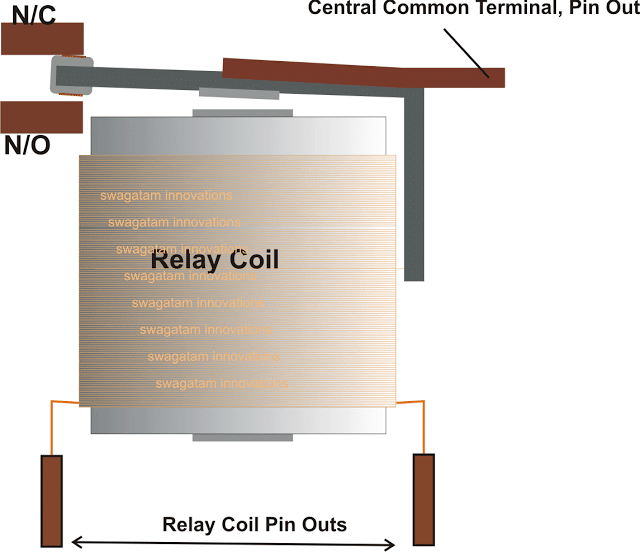
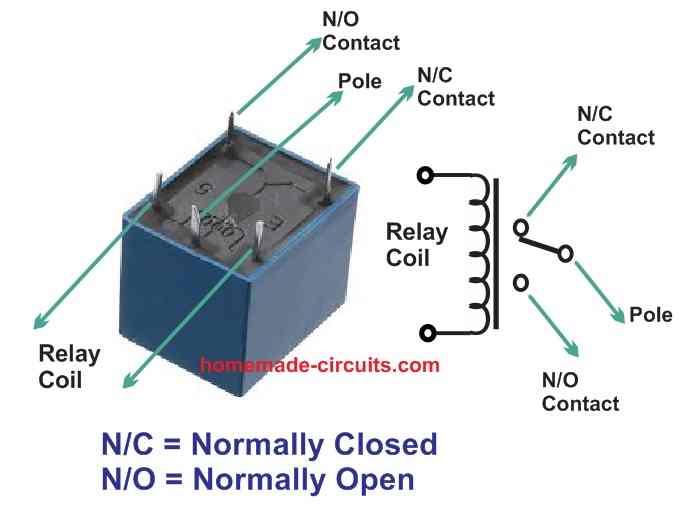
- A relay mechanism basically consists of a coil and a spring loaded contact which is free to move across a pivoted axis.
- The central pole is hinged or pivoted in such a way that when the relay coil is powered with voltage, the central pole joins with one of the side terminals of the device called the N/O contact (Normally Closed).
- This happens because the pole iron gets attracted by the relay coil electromagnetic pull.
- And when the relay coil is switched OFF, the pole disconnects itself from the N/O (Normally Open) terminal and joins itself with a second terminal called the N/C contact.
- This is the default position of the contacts, and happens due to the absence of an electromagnetic force, and also due to the spring tension of the pole metal which normally keeps the pole connected with the N/C contact.
- During such switch ON and switch OFF operations it switches from N/C to N/O alternately depending upon the ON/OFF states of the relay coil
- The coil of the relay which is wound over an iron core behaves like a strong electromagnet when a DC is passed through the coil.
- When the coil is energized the generated electromagnetic field instantly pulls the nearby spring loaded pole metal implementing the above explained switching of the contacts
- The above movable spring loaded pole inherently forms the main central switching lead and its end ts terminated as the pinout of this pole.
- The other two contacts N/C and the N/O form the associated complementary pairs of relay terminals or the pin outs which alternately get connected and disconnected with the central relay pole in response to the coil activation.
- These N/C and N/O contacts also have end terminations which move out of the relay box to form the relevant pinouts of the relay.
The following rough simulation shows how the relay pole moves in response to the electromagnet coil when switched ON and OFF with an input supply voltage. We can clearly see that initially the central pole is held connected with the N/C contact, and when the coil is energized, the pole is pulled downwards due to the electromagnetic action of the coil, forcing the central pole to connect with the N/O contact.
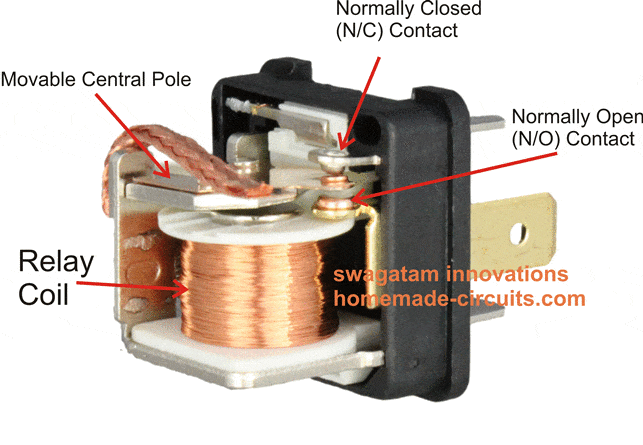
Video Explanation
Thus basically there are three contact pinouts for a relay, namely the central pole, the N/C and the N/O.
The two additional pinouts are terminated with the coil of the relay
This basic relay is also called a SPDT type of relay meaning single pole double throw, since here we have a single central pole but two alternate side contacts in the form of N/O, N/C, hence the term SPDT.
Therefore in all we have 5 pinouts in an SPDT relay: the central movable or switching terminal, a pair of N/C and the N/O terminals and finally the two coil terminals which all together constitute a relays pin outs.
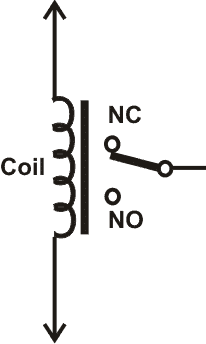
How to identify Relay Pinouts and Connect a Relay
Normally and unfortunately many relays don’t have there pinout marked, which makes it difficult for the new electronic enthusiasts to identify them and make these work for the intended applications.
The pinouts that needs to be identified are (in the given order):
- The coil pins
- The Common Pole pin
- The N/C pin
- The N/O pin
The identification of a typical relays pinouts may be done in the following manner:
1) Position the multimeter in the Ohms range, preferably in the 1K range.
2) Begin by connecting the meter prods to any of the two pins of the relay randomly, until you find the pins which indicate some kind of resistance on th meter display. Typically this may be anything between 100 ohm and 500 Ohm. These pins of the relay would signify the coil pinouts of the relay.
3) Next, follow the same procedure and proceed by connecting the meter meter prods randomly to the remaining three terminals.
4) Keep doing this until you find two pins of the relay indicating a continuity across them. These two pinouts will be obviously the N/C and the pole of the relay, because since the relay is not powered the pole will be attached with the N/C due to internal spring tension, indicating a continuity across each other.
5) Now you need to simply identify the other single terminal which may be oriented somewhere in across the above two terminals representing a triangular configuration.
6) In most cases the central pinout from this triangular configuration would be your relay pole, the N/C is already identified and therefore the last one would be your relay's N/O contact or pinout.
The following simulation shows how a typical relay may be wired with a DC voltage source across its coils and a mains AC load across its N/O and N/C contacts
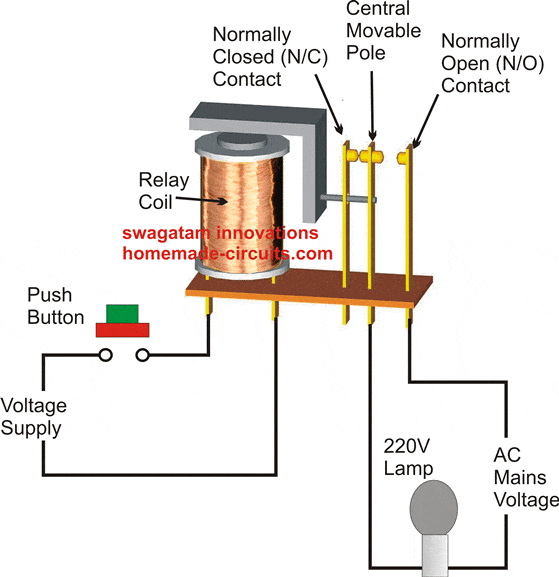
These three contacts may be further confirmed by powering the relay coil with the specified voltage and by checking the N/O side with the meter for a continuity..
The above simple procedure could be applied for identifying any relay pinout which may be unknown to you, or unlabelled.
Now since we have thoroughly studied how a relay works and how to identify the pinouts of a relay, it would be also interesting to know the details of the most popular type of relay which is mostly used in small electronic circuits, and how to connect it.
If you want to know how to design and configure a relay driver stage using a transistor, you can read it in the following post:
How to make a transistor relay driver circuit
A Typical Chinese Make Relay PinOuts
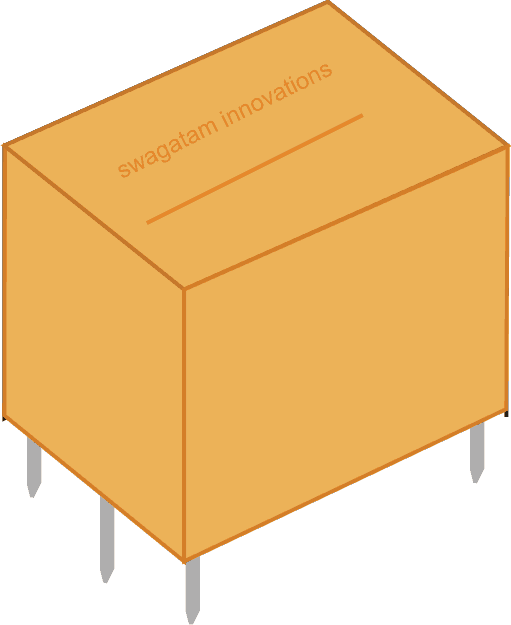
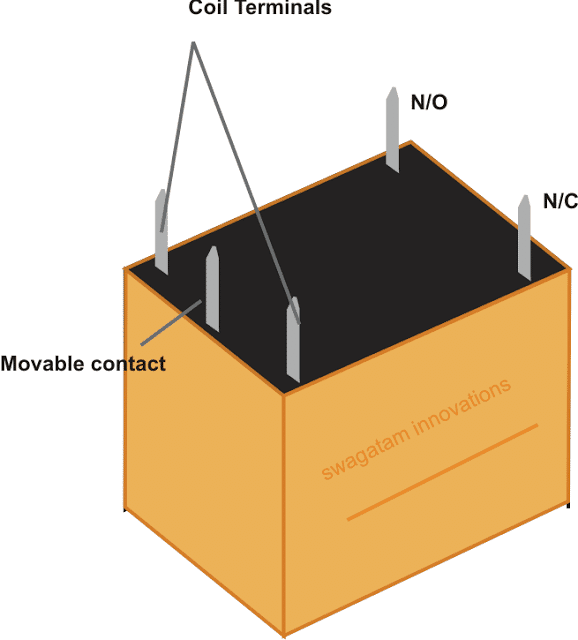
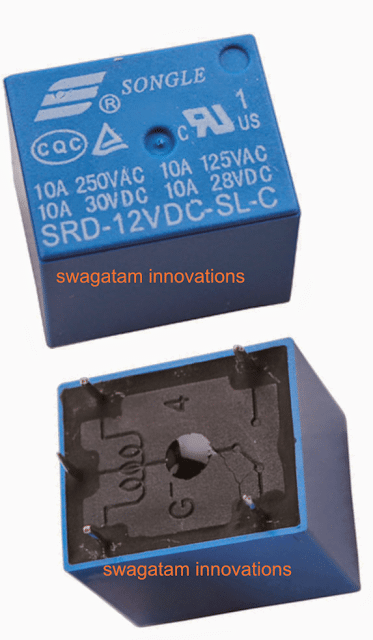
How to Wire Relay Terminals
The following diagram shows how the above relay may be wired with a load, such that when the coil is energized, the load gets triggered or switched ON through its N/O contacts, and through the attached supply voltage.
This supply voltage in series with the load may be as per the load specifications. If the load is rated at DC potential then this supply voltage could be a DC, if the load is supposed to be an AC mains operated then this series supply could be a 220V or 120V AC as per the specifications.
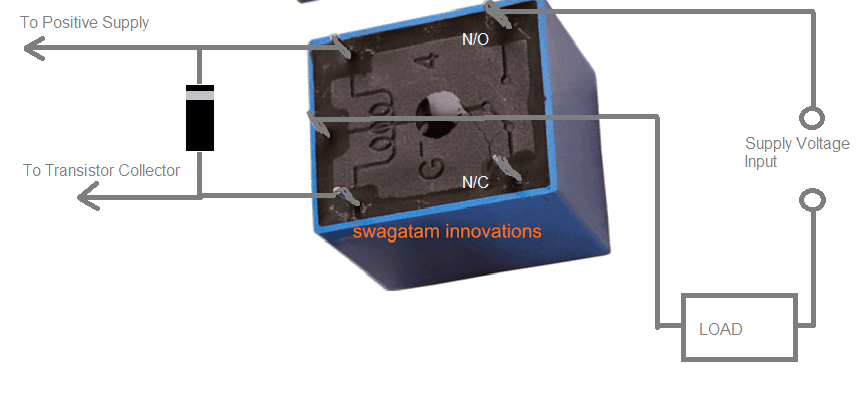
Why is a Diode so Crucial across a Relay Coil
Whenever a relay is used in a circuit, you might have noticed a rectifier diode or a capacitor compulsorily connected parallel to the relay coil.
This diode is called the flyback diode or the freewheeling diode. It is basically introduced to protect the driver transistor from the dangerous reverse back EMF of the relay coil.
You might have wondered, why is a diode always seen across a relay coil? The following section explains why a flyback or a freewheeling diode is so crucial across a relay coil.
The answer lies in the fascinating yet a potentially destructive property of inductors.
We know that, just like capacitors inductors also store electric current (DC) inside its winding. Larger the winding, larger the amount of DC voltage its stores.
A relay coil is also an inductor which has a significantly high number of turns in its winding, and therefore its capacity to store a DC voltage is proportionately huge.
When the relay transistor is switched ON, the relay also switches ON, and it stores a calculated amount of DC voltage within its winding.
Now, as soon as the transistor is switched OFF, the potential across the relay coil is removed. In this situation, the DC voltage stored inside the relay coil has to escape somehow. It tries to discharge through anything that's connected with it. This is known as the relay reverse back EMF, which may have a reverse voltage that's many times larger than the actual DC voltage fed to the relay coil.
Since the driver transistor is connected with the relay, this large reverse EMF tries to force through the transistor emitter/collector. The word "reverse" is used because this back EMF is negative in polarity. Being negative in polarity this back EMF tries to force through the emitter towards the collector, causing an instant damage to the transistor.
In order to neutralize the above reverse back EMF a flyback diode or a freewheeling diode is always connected across a relay coil. This diode can be a simple 1N4007 diode for most of the relays (upto 30 amps).
As long as the relay remains switched ON through the driver transistor, the diode remains negatively biased and has no effect on the operation of the relay. However, when the relay is switched OFF, the diode becomes forward biased for the reverse EMF kicking out from the relay coil.
This back EMF now finds an easy path through the forward biased diode and short circuits through the diode. In this way the dangerous relay coil reverse EMF is neutralized and short circuited through the diode which totally safeguards the driver transistor from any possible damage.
If a diode is not available a high value electrolytic capacitor can be also used. The capacitor can function in the same way. It allows a reverse short circuit path for the back EMF and protects the transistor from getting damaged.
What if a Driver Transistor is not used and the Relay is Operated Directly from a Power Supply?
Even in this situation a freewheeling diode must be connected across a relay coil. Because the reverse back EMF from the relay coil may still have the potential to force enter the power supply or any associated circuitry and cause damage to the vulnerable electronic parts.
How to Calculate relay Flyback Diode
This may not be easy actually, because there are no easy formulas to calculate the relay flyback diode.
However, the rule of thumb is that, the reverse EMF current can be never higher than the actual current rating of the relay coil. Although the voltage could be many times higher.
A 1N4007 fits the bill for almost all relay driver applications (below 24 V and above 100 Ohm relays)
This is because a PIV of a 1N4007 is 1000 V and the current handling capacity is 1 amp. For most applications, the back EMF from a relay coil can never exceed the above ratings of the 1N4007 diode.
Even for a massive 12V 100 ohm relay, its coil current would be:
I = 12 / 100 = 120 mA. Thus the back EMF current will be much smaller than this. A 1N4007 will be perfectly able to handle this reverse current.
